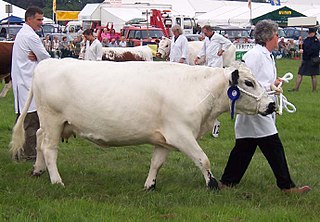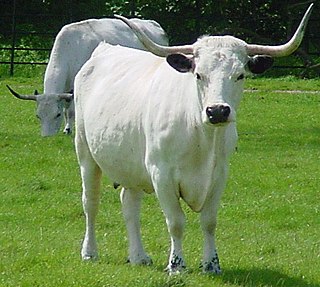
Port Talbot is a town and community in the county borough of Neath Port Talbot, Wales, situated on the east side of Swansea Bay, approximately eight miles from Swansea. The Port Talbot Steelworks covers a large area of land which dominates the south east of the town. It is one of the biggest steelworks in the world, but has been under threat of closure since the 1980s. The population was 31,550 in 2021, comprising about a fifth of the 141,931 population of Neath Port Talbot.

The Aberdeen Angus, sometimes simply Angus, is a Scottish breed of small beef cattle. It derives from cattle native to the counties of Aberdeen, Banff, Kincardine and Angus in north-eastern Scotland. In 2018 the breed accounted for over 17% of the beef production in the United Kingdom.

Neath Port Talbot is a county borough in the south-west of Wales. Its principal towns are Neath, Port Talbot, Briton Ferry and Pontardawe. The county borough borders Bridgend County Borough and Rhondda Cynon Taf to the east, Powys and Carmarthenshire to the north; and Swansea to the west.

The Longhorn or British Longhorn is a British breed of beef cattle characterised by long curving horns. It originated in northern England, in the counties of Lancashire, Westmorland and Yorkshire, and later spread to the English Midlands and to Ireland. It was originally a slow heavy draught animal; cows gave a little milk, although high in fat. In the eighteenth century Robert Bakewell applied his methods of selective breeding to these cattle, which for a short time became the predominant British breed. Both the numbers and the quality of the breed declined throughout the nineteenth century and for much of the twentieth. A breed society was formed in 1878, and a herd-book published in that year.

Aberavon is a town and community in Neath Port Talbot county borough, Wales. The town derived its name from being near the mouth of the river Afan, which also gave its name to a medieval lordship. Today it is essentially a district of Port Talbot, covering the central and south western part of the town. Aberavon is also the name of the nearby Blue Flag beach and the parish covering the same area.

The Dexter is an Irish breed of small cattle. It originated in the eighteenth century in County Kerry, in south-western Ireland, and appears to be named after a man named Dexter, who was factor of the estates of Lord Hawarden on Valentia Island. Until the second half of the nineteenth century it was considered a type within the Kerry breed.

Margam Castle, Margam, Port Talbot, Wales, is a late Georgian country house built for Christopher Rice Mansel Talbot. Designed by Thomas Hopper, the castle was constructed in a Tudor Revival style over a five-year period, from 1830 to 1835. The site had been occupied for some 4,000 years. A Grade I listed building, the castle is now in the care of Neath Port Talbot County Borough Council.

Margam Country Park is a country park estate in Wales, of around 850 acres (3.4 km2). It is situated in Margam, about 2 miles (3 km) from Port Talbot in south Wales. It was once owned by the Mansel Talbot family and is now owned and administered by the local council, Neath Port Talbot County Borough Council. Situated within the park are three notable buildings: Margam Abbey, a Cistercian monastery; Margam Castle, a neo-Gothic country house that was once the seat of the Mansel Talbot family; and the 18th-century Orangery. The park is designated Grade I on the Cadw/ICOMOS Register of Parks and Gardens of Special Historic Interest in Wales.

The Belted Galloway is a traditional Scottish breed of beef cattle. It derives from the Galloway cattle of the Galloway region of south-western Scotland, and was established as a separate breed in 1921. It is adapted to living on the poor upland pastures and windswept moorlands of the region. The exact origin of the breed is unclear, although the white belt for which they are named, and which distinguishes the breed from black Galloway cattle, is often surmised to be the result of cross-breeding with the similarly-coloured Dutch Lakenvelder breed.

The South Devon is a British breed of large beef cattle. It originated in the counties of Devon and Cornwall in south-west England, and is mentioned from the eighteenth century. It was a dual-purpose breed, kept both for its milk and for beef. Since 1972 selection has been for beef only.

The British White is a British breed of beef cattle. It is naturally polled and is colour-pointed – white with black or red points on the ears and muzzle. It has a confirmed history dating back to the seventeenth century.

The White Park is a modern British breed of cattle. It was established in 1973 to include several herds or populations of colour-pointed white cattle – white-coated, with points of either red or black on the ears and feet. Such cattle have a long history in the British Isles, and the origins of some herds go back to the Middle Ages.

The Old Gloucester or Gloucester is a traditional British breed of cattle originating in Gloucestershire and surrounding areas in the West Country of England. It was originally a triple-purpose breed, reared for milk, for beef and for draught use; it is now a dual-purpose animal. It is an endangered breed, and its conservation status is listed as "priority" by the Rare Breeds Survival Trust.
Pembroke cattle were a breed of dual-purpose short-legged, hardy, black cattle native to Wales. A society was formed in 1867 to try to improve the breed, and the first register of Pembroke cattle was published in 1874. Pembroke cattle were registered with black cattle from North Wales in 1904, to create the Welsh Black breed.

The Sussex is a British breed of red beef cattle from the Weald of Sussex, Surrey and Kent, in south-eastern England. Its traditional use as a draught ox on the Weald continued into the twentieth century. From the late nineteenth century it began to be selectively bred for beef production. It has been exported to many countries of the world; the largest population is in South Africa, where there may be half a million head.
Canterbury Oast Trust (COT) is a registered charity in England providing accommodation, care and training for people with learning disabilities in Kent and East Sussex.

The Welsh is a breed of domestic pig native to Wales. It is a large white breed known for its hardiness in outdoor (extensive) farming, its long, pear-shaped body and its lop-ears. The breed was first mentioned in the 1870s, and after the Howitt committee report in 1955, became the third most common sire in the United Kingdom after the Large White pig and British Landrace pig. The Welsh pig experienced a decline in numbers in the late twentieth century because consumer demands had changed and the carcase was considered too fatty. In 2005 the breed was considered endangered and later came under the auspices of the Rare Breeds Survival Trust. Since then numbers have expanded somewhat, and by 2012, the registered breeding herd had increased to over 1000 animals.
The Blue Albion was a British breed of cattle with an unusual blue roan coat. It originated in the English Midlands in the late nineteenth or early twentieth century, and was a dual-purpose breed, reared both for beef and for milk. It became extinct following the foot-and-mouth outbreak of 1967.

The Vaynol is one of the United Kingdom's rarest breeds of cattle with less than 150 breeding animals registered. The breed is currently listed as “critical” on the Rare Breed Survival Trust list. There are currently three officially registered herds of Vaynol cattle existing in the United Kingdom. Together with the Chillingham and White Park cattle, the Vaynol is one of three horned breeds derived from ancient white parkland herds from Britain and Ireland. These park cattle were also the basis of a similar fourth breed, the polled British White.

The cuisine of the Vale of Glamorgan, Wales, is noted for its high-quality food produced from the fertile farmland, river valleys and coast that make up the region. The area has a long history of agriculture that has developed from the Roman era.

















